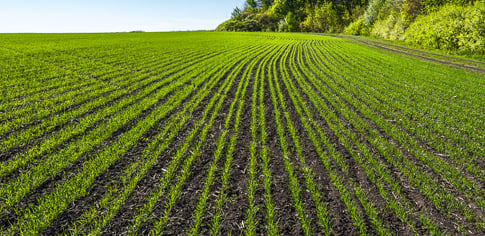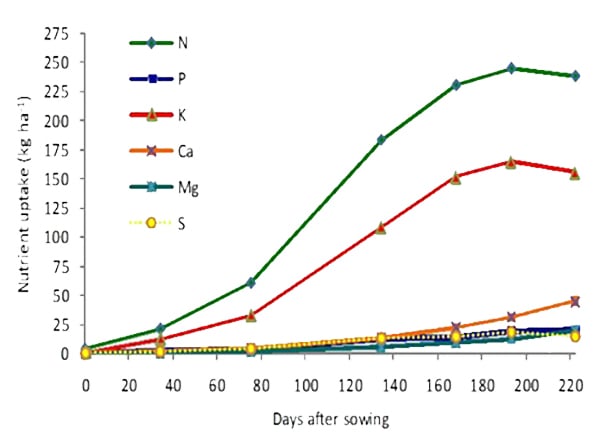Growing Wheat
Crop Nutrition Advice
Everything you need to know about wheat fertilization, best practice, suitable products, field trials and more
Advice for growing Wheat (Triticum spp.)
-
Optimal pH for winter wheat is 6.5.
-
Yields of most cultivars can be markedly reduced where pH is below 5.5, mainly due to susceptibility to P, Mo and Ca deficiencies.
-
In pH >7.5 deficiencies of B, Cu, Fe, Mn, P and Zn are likely to appear. Wheat can be grown on practically all soil types, except on very light sandy soils, or on peaty ones.
-
Winter wheat is widely grown throughout temperate zones (in Europe, Asia and America, up to 60°N), and at higher elevations in some tropical/sub-tropical areas.
-
The most favorable temperature for flowering, grain initiation, grain formation and maturing is at 20–25°C.
-
Wheat is a typical long day crop.

Healthy winter wheat at growing stage

Wheat field close-up
Nutrient requirements Estimated nutrient uptake (kg/ha):
| Variety | Yield | N | P2O5 | K2O | |
|---|---|---|---|---|---|
| t/ha | kg/ha | kg/ha | kg/ha | ||
| Winter wheat | Biomass* (DM) | 13.7 | 187 | 55 | 252 |
| Winter wheat | Grains | 6.7 | 130 | 39 | 51 |
| Spring wheat | Biomass* (DM) | 9.0 | 129 | 58 | 125 |
| Spring wheat | Grains | 4.5 | 100 | 50 | 25 |
Source: Adapted from Aigner et al., 1988
Dynamic of nutrient uptake over a crop season in wheat

Reference: Hirzel and Undurraga, 2013
Role of nutrients
| Key parameter | N | P2O5 | K2O | MgO | CaO | SO3 |
|---|---|---|---|---|---|---|
| Yield | +++ | + | ++ | + | + | + |
| Protein level | +++ | + | ++ | + | +++ | |
| Vegetative growth | +++ | + | + | ++ | + | + |
| Root system | + | +++ | + | ++ |
– = decreasing
+/- = different results, depending on the rate of nutrient applied
Source: IPI bulletin – Cereals
Source: Whinter wheat – Crop advice sheet (Agronomy Campus)
Nutrient deficiencies
Nitrogen
Plants are pale green to yellow with chlorosis beginning on lower leaves and progressing upwards as the deficiency intensifies; plants have spindly stems and growth is slow.
Phosphorous
P deficient plants may remain darker green than normal plants and develop purple discoloration first on the underside and later throughout. Leaf tips may die back when P deficiency is severe. Plants grow slowly, stems are thin and shortened and maturity is delayed. P deficient plants also exhibit poor tillering.
Potassium
K deficiency is initially manifested as chlorosis on the older leaves and progresses upwards as the deficiency intensifies. .The leaves eventually become streaked and take on a scorched appearance along the leaf margins. Chlorotic areas may develop throughout the leaf. Deficiency symptoms can occur in young leaves of some fast-maturing high-yielding varieties. Stems of deficient plants are weak and tend to lodge.
Sulfur
Symptoms are similar to nitrogen deficiency, but the chlorosis is uniform and general, throughout the entire plant, including younger leaves. Sulfur deficiency is most likely on sandy, free draining and soils low in organic matter.
Calcium
Ca deficiency is very rare on small grains. Plants are severely stunted, and new leaves exude a gelatinous-like material, causing new leaves to stick together. Because Ca deficiency is favored by low pH 5.2 and low soil Ca, aluminum-, and manganese- toxicity symptoms will usually be exhibited before Ca deficiency symptoms.
Magnesium
Typically, Mg deficiency is found on soils with a pH of less than about 5.2. Also, wheat is unable to absorb adequate Mg in cool, wet springs.
Zinc
Cereals Zn deficiency generally shows up in early growth stages, when plant is only ~10 cm high, appearing first as yellow streaks in the young leaves, with a white to yellowish tip. White spots often appear on the leaves, or along their edges, and a portion of the marginal area may die. The entire plant is frequently stunted.
Boron
Terminal shoots die. Leaves die back from tips, and young leaves remain rolled. (Similar to calcium deficiency) B- deficient plants produce very thin ears with much reduced grain yield.
Copper
Cu deficiency tends to appear in the youngest leaves. Leaf twisting and white leaf tipping. Severe yield reduction. Copper deficiency may be due to low soil availability, or low total soil copper, and is problematic on light, acidic soils, low soil organic matter, granite parent materials, and dry soil.
Iron
Iron deficiency starts out as an interveinal chlorosis of the youngest leaves, evolves into an overall chlorosis, and ends as a die-back of the chlorotic leaves.
Manganese
At early stages, light chlorosis appears on the young leaves. At more severe cases, mature leaves show netted veins. Then leaves develop brown-grey necrosis along the veins. Chlorotic flecks pattern, concentrated mainly at the leaf base.
Source: https://vikaspedia.in
The influence of nutrient for wheat resistance
| Disease | Pathogen | Increase resistant | Decrease resistant |
|---|---|---|---|
| Roots: | |||
| Take-all disease | Gaeumannomyces graminis var. tritici | N-NH4, Mn, Cu, Cl | N-NO3 |
| Fusariosis | Fusarium ssp. | Zn, Cl | K |
| Leaves: | |||
| Powdery mildew of cereales | Erysiphe graminis | K, S, Mn | N, Zn |
| Black stem rust | Puccinia graminis | K, S | |
| Brown rust | Puccinia recondite f. sp. Tritici | K, Mn, Cl | Cu |
| Septoria tritici | K, Cl | P | |











